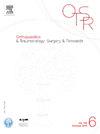Distal radius fractures after 75 years of age: are six-month functional and radiological outcomes better with plate fixation than with conservative treatment?
IF 2.2
3区 医学
Q2 ORTHOPEDICS
引用次数: 0
Abstract
Background
Surgery and non-operative treatment produce similar 1-year functional outcomes in patients older than 65 years. Data are lacking for patients older than 75 years. The main objective of this study was to compare surgical vs. non-operative treatment regarding short-term outcomes in patients older than 75 years. In addition to an overall analysis, sub-group analyses were done in patients with displacement and severe displacement (>20 ° posterior tilt).
Hypothesis
Surgery provides better clinical and radiological outcomes than does non-operative treatment.
Patients and methods
Patients older than 75 years at the time of a distal radius fracture were included prospectively over a 2-year period. A follow-up duration of at least 6 months was required. Treatment choices were based on displacement, Charlson’s Co-morbidity Index, and patient autonomy. Surgery consisted in open fixation using an anterior locking plate and non-operative treatment in a short arm cast without reduction. The main assessment was based on clinical criteria: range of motion, strength, visual analogue scale (VAS) scores, the short version of the Disabilities of the Arm, Shoulder, and Hand tool (QuickDASH), the Patient Rated Wrist Evaluation (PRWE), and the 36-Item Short Form Health Survey (SF-36). The secondary assessment criteria were the radiological outcomes and the complications.
Results
74 patients were included, among whom 24 were treated surgically and 50 non-operatively. At 1.5 months, surgery was associated with significantly better results for flexion, ulnar inclination, and supination, with range increases of at least 7 ° vs. non-operative treatment, and with greater dorsal angle and ulnar variance values (p < 0.05 for all comparisons). At 6 months, pronation and the radio-ulnar index were better with surgery (p < 0.05 for both comparisons). In the patients with displacement or severe displacement, surgery was associated with 10° gains vs. conservative treatment for flexion, ulnar inclination, and supination at 1.5 months (p < 0.05 for all comparisons).
Discussion
In patients older than 75 years, surgery for distal radius fracture was associated with significantly better clinical and radiological outcomes within 6 months. Surgery is recommended for displaced and severely displaced distal radius fractures to expedite the recovery of joint motion ranges. Beyond 6 months, the outcomes are similar.
Level of evidence
III.
75 岁以后的桡骨远端骨折:钢板固定的 6 个月功能和放射学疗效是否优于保守治疗?
背景:对于 65 岁以上的患者,手术和非手术治疗的 1 年功能疗效相似。对于 75 岁以上的患者则缺乏相关数据。本研究的主要目的是比较 75 岁以上患者手术治疗与非手术治疗的短期疗效。除总体分析外,还对有移位和严重移位(后倾>20°)的患者进行了分组分析:假设:与非手术治疗相比,手术治疗能提供更好的临床和放射学效果:患者和方法:对桡骨远端骨折时年龄超过 75 岁的患者进行为期两年的前瞻性研究。随访时间至少需要 6 个月。根据移位情况、查尔森共病指数和患者自主性选择治疗方案。手术包括使用前方锁定钢板进行开放式固定,以及使用短臂石膏进行非手术治疗,但不进行复位。主要评估基于临床标准:活动范围、力量、视觉模拟量表(VAS)评分、短版手臂、肩部和手部残疾工具(QuickDASH)、患者腕部评价(PRWE)和 36 项简表健康调查(SF-36)。次要评估标准为放射学结果和并发症:共纳入 74 名患者,其中 24 人接受手术治疗,50 人接受非手术治疗。1.5 个月后,手术治疗在屈曲、尺侧倾斜和仰卧方面的效果明显更好,与非手术治疗相比,手术范围至少增加了 7°,背角和尺侧变异值也更大(P 讨论):对于 75 岁以上的患者,桡骨远端骨折手术治疗在 6 个月内的临床和影像学效果明显更好。建议对移位和严重移位的桡骨远端骨折进行手术治疗,以加快关节活动范围的恢复。6个月后的结果类似:证据等级:III。
本文章由计算机程序翻译,如有差异,请以英文原文为准。
求助全文
约1分钟内获得全文
求助全文
来源期刊
CiteScore
5.10
自引率
26.10%
发文量
329
审稿时长
12.5 weeks
期刊介绍:
Orthopaedics & Traumatology: Surgery & Research (OTSR) publishes original scientific work in English related to all domains of orthopaedics. Original articles, Reviews, Technical notes and Concise follow-up of a former OTSR study are published in English in electronic form only and indexed in the main international databases.

 求助内容:
求助内容: 应助结果提醒方式:
应助结果提醒方式:


